- info@naturebylennart.com

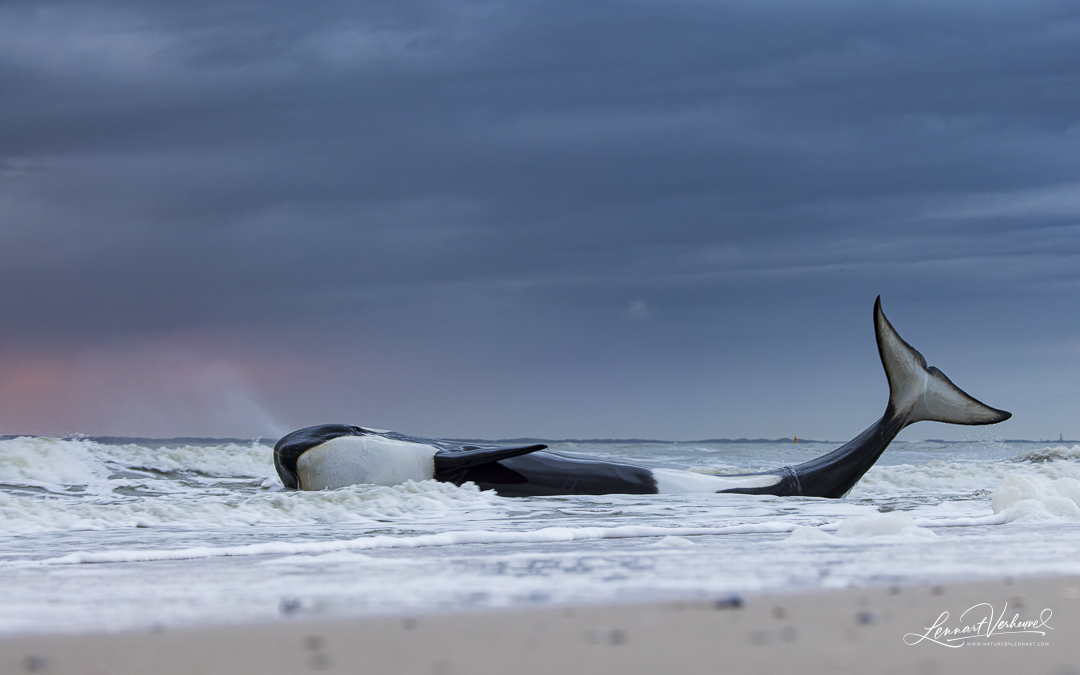
Last week I was awarded at the Wildlife Photographer of the Year competition. For me this competition has always been like the Oscars of nature photography. This competition, organized by the Natural History Museum in London, is the oldest and most prestigious competition within this kind of photography. For many nature photographers it is a dream to be successful here. At least that was the case for me. I thought it would be could to tell the story behind the photo in more detail on my own website. So here goes!
On October 15, 2022, in the afternoon, I was behind my computer editing some pictures. Suddenly I saw a message arrive via Web Whatsapp: an Orca was stranded on the coast of Zeeuws-Vlaanderen! Someone had seen this on the Facebook page of a beach club and shared it in the local WhatsApp group for alerting special mammals. The low-quality phone video indeed left nothing to the imagination: without a doubt an Orca had washed up there! I immediately went into high gear because I had never seen an Orca before and in any condition: I really wanted to see one. The stranding of a live Orca is very rare in the Netherlands. I could only remember the Orca Morgan that finally ended up in a dolphinarium in Tenerife.
So I ran downstairs where my sister happened to be. She wanted to come along. We went to Zeeuws-Vlaanderen by car. Even though I live in Zeeland, the west coast of Zeeuws-Vlaanderen is still about an hour’s drive away. I knew I had to be at Cadzand-Bad, but I didn’t know where exactly. I just drove to the location of the beach bar that had posted the video on Facebook. When we arrived, we met two Belgian birdwatchers who told me that the Orca had been pushed back into the sea. The Orca had apparently swum away in the direction of Belgium. Good news for the Orca! I was just too late, but that’s how it goes. I was just thinking about whether I should search the sea from the dike when a second message came in.
Another Orca had beeched. Perhaps the same or a second Orca. From Walcheren, about 15 kilometers away, a message came from another bird watcher, Lenn van de Zande, who was able to indicate exactly where the Orca might be lying. Due to the crowd of people, he could even see it with a telescope from miles away. The dot turned out to have been placed just right. I drove there and when I walked over the dike I saw the Orca already lying there. I immediately ran downstairs. There I could really get a good look at the Orca. The animal looked huge to me. It would later turn out that she (it was a female) was 5.5 meters long and weighed approximately 2000 kilos.
While I was waiting, I took some pictures.
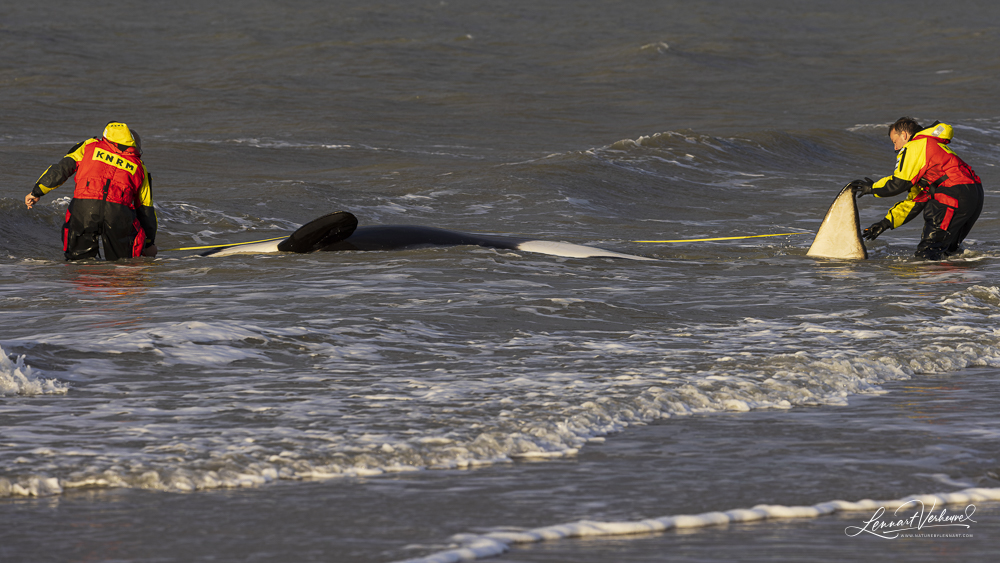
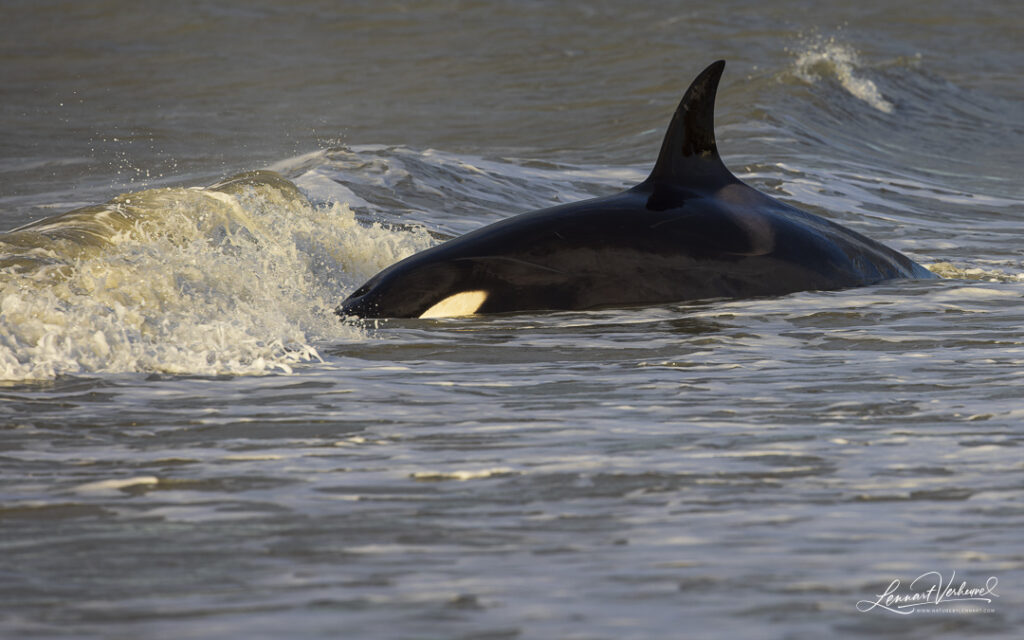
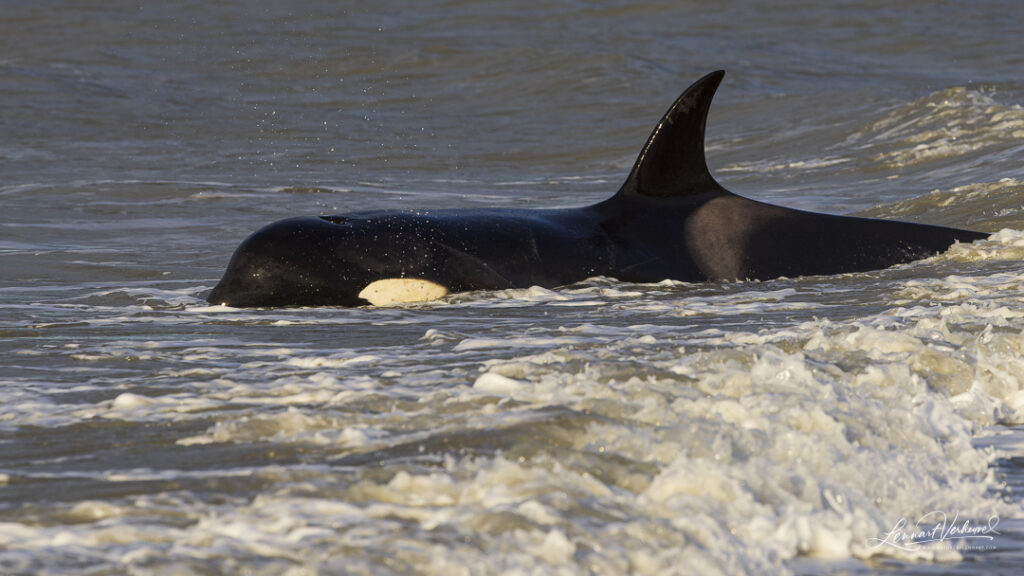
Once the Orca turned upright when a fairly large wave came in, but the effort was in vain. The afternoon passed. I had some conversations with bird watchers I knew, who mainly came from Belgium, and when evening fell I decided to walk back.
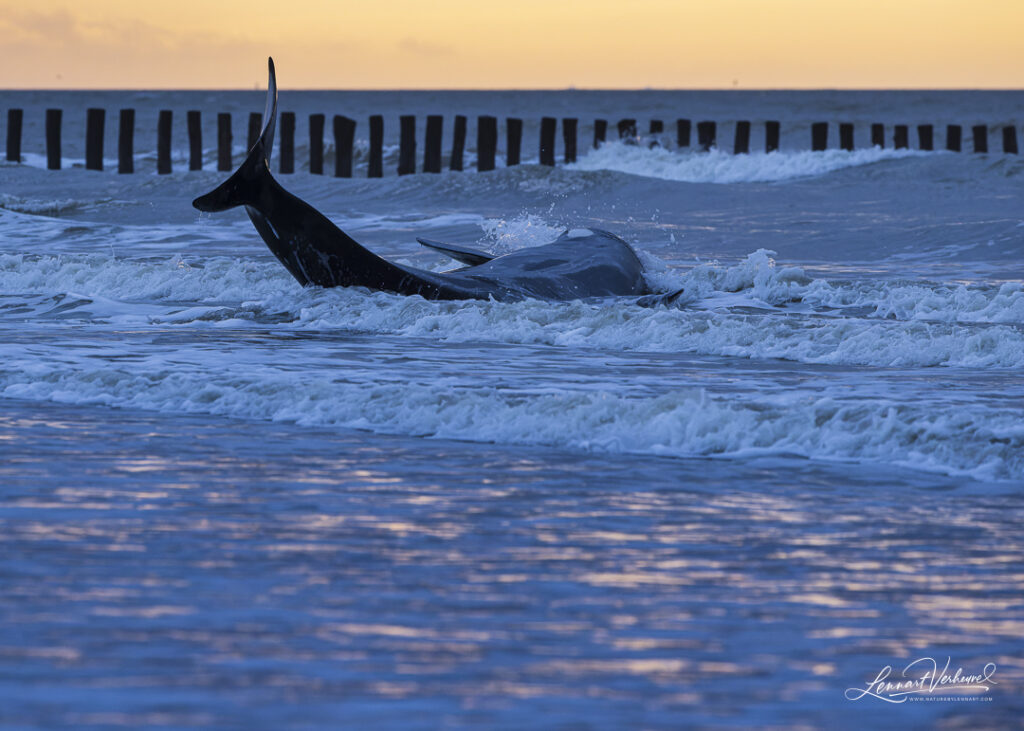
As I turned around I saw that the sky was now very dark, but that there also was a beautiful red glow of the setting sun. I decided to go a little closer so that I could take in as much as possible of the Orca and its surroundings with my lens zoomed all the way out. On my Canon RF 100-500 millimeter lens this was 100 millimeters. I waited for a moment when the orca raised its tail. The slow shutterspeed allowed me to show the crashing waves over the Orca.
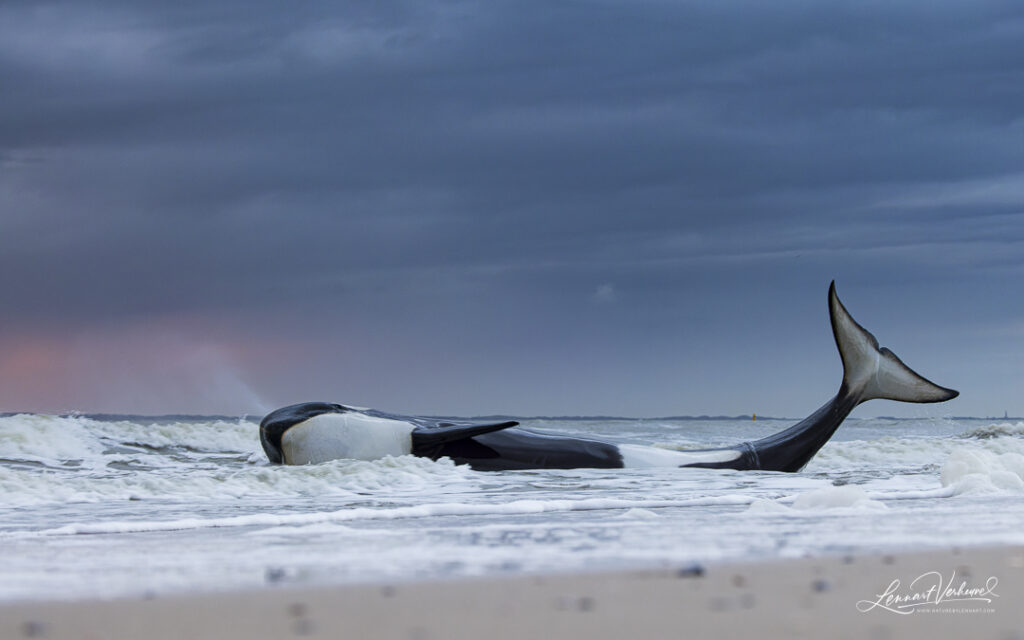
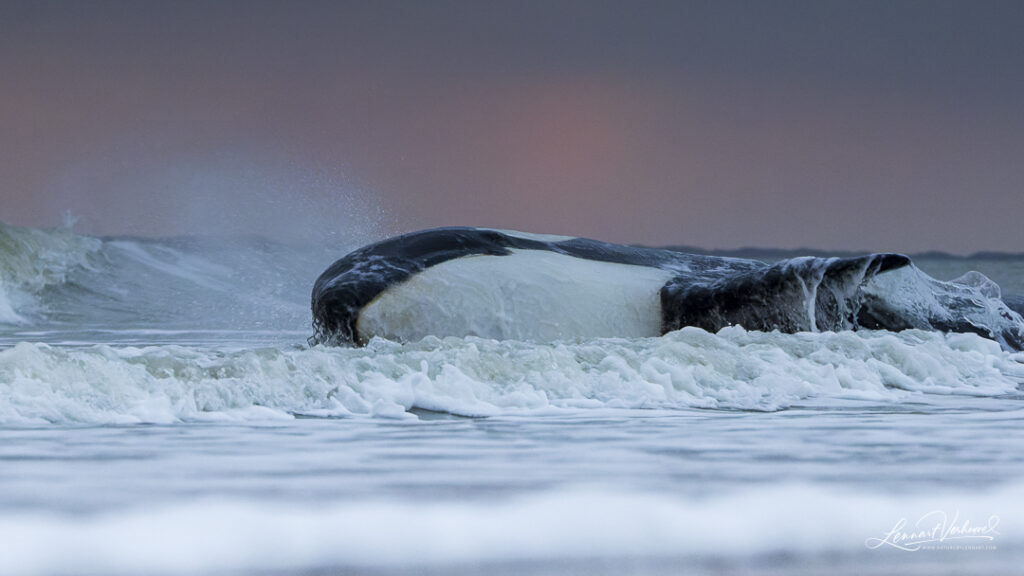
Once I had taken some pictures of it, I decided that it was really time to go home.
It would later turn out that the Orca would not survive that evening. Unfortunately, there were no good options left for the animal. Returning it to the sea turned out to be impossible and the animal was too heavy to transfer to a shelter. When low tide fell, the Orca lay completely isolated on the sand and its fate was decided. That evening the Orca died.
Later, Utrecht University conducted research into the cause of the Orca’s death. It turned out that the Orca had various inflammations in, among other things, the heart valve, the meninges and the genitals. The gums were also inflamed, the Orca had several rotting teeth and had not eaten for days. Most likely the Orca would have been doomed even if we had managed to get her back into the sea. See more information here (only in Dutch).
Interesting news then came from Spain from the organization Proyecto O.R.C.A Cádiz. The Orca turned out to belong to the ‘Lusas’ clan as part of the Iberian population of Orcas. These Orcas are normally only seen in Portuguese waters. This Orca had been given the code name ‘IB6 Gala’. This Orca was usually accompanied by a male believed to be her brother or son. It was very unusual for an Orca from this population to come so far north. The Orca was aproximately twenty years old. Link to the post on Facebook from Proyecto O.R.C.A. Cádiz (in English and Spanish).
I posted my photo online that evening and I received many reactions. A few more reactions than I usually get for a picture, so I had the feeling that the photo had made an impression on many people. Coincidentally, registration for Wildlife Photographer of the Year had just opened at that time. I had participated in that competition once before, but with no great success. Now I thought I had a few special photos again, so I submitted this pictures in addition to the 24 others that I was allowed to submit.
I didn’t hear anything back for a long time until at the beginning of 2023 a request came up to provide a RAW photo. This meant that one of my photos had caught the jury’s attention and was among the last 100 photos in that category. I had already experienced this the previous time with two of my other photos, so I didn’t think that much of it. Still, this was the photo of the Orca! Weeks passed again and I heard nothing. In the meantime I went on a trip to India. When I was staying in the high Himalayas and had just seen my first Pallas’ Cat that afternoon, I suddenly received an email. That turned out to be a message from the Wildlife Photographer of the Year competition.
My heart skipped a beat. I opened the message and it stared back at me in large letters: I had become a category winner in the “Oceans, the bigger picture” category! I could hardly believe it. I even thought for a moment that I might receive another message shortly afterwards telling me that it had been a mistake after all. However, it had to be real. Especially when I later received more messages in which I was aksked to provide all kinds of information. For me it was a dream come true: I had hoped that my picturewould be successful, but becoming a category winner was a huge success! This meant that my photo would also automatically compete for the ‘grand title’. I didn’t even dare to dream of that.
I would go and see it all. A lot of time would pass before the awards ceremony on October 10. In the coming months I provided all kinds of information and prepared for the trip to London. I even had a tailor-made suit fitted to me because I wanted to look good on that awardnight!
I set out to London with my sister. She had helped me with all the titles of the 25 photos I had submitted, so I had promised her that she would be allowed to come along if I won something. So that was already determined! We left for London by train on October 9.
There we admired the Natural History Museum in the afternoon. I thought it was special to see a number of extinct animals put on display. Eye-catchers were Great Auk, Dodo and Archeopteryx.
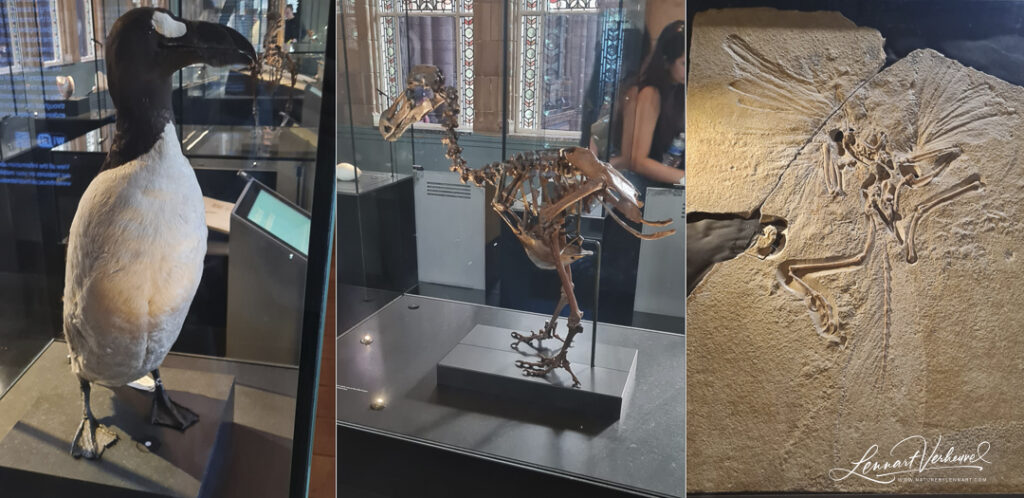
Left to right: Great Auk, Dodo and Archaeopteryx
In the evening there was a Photographers Welcome Reception where we could meet other photographers and people from the museum. There I met many new people and saw a familiar face here and there.
The next day was the big day of the awards ceremony. We took it easy during the day and visited some places in London. We were expected at 7 o’clock in the evening. There we were in the large room with the blue whale above it. At the front of the stage it said in large letters: ‘WPY 59’.
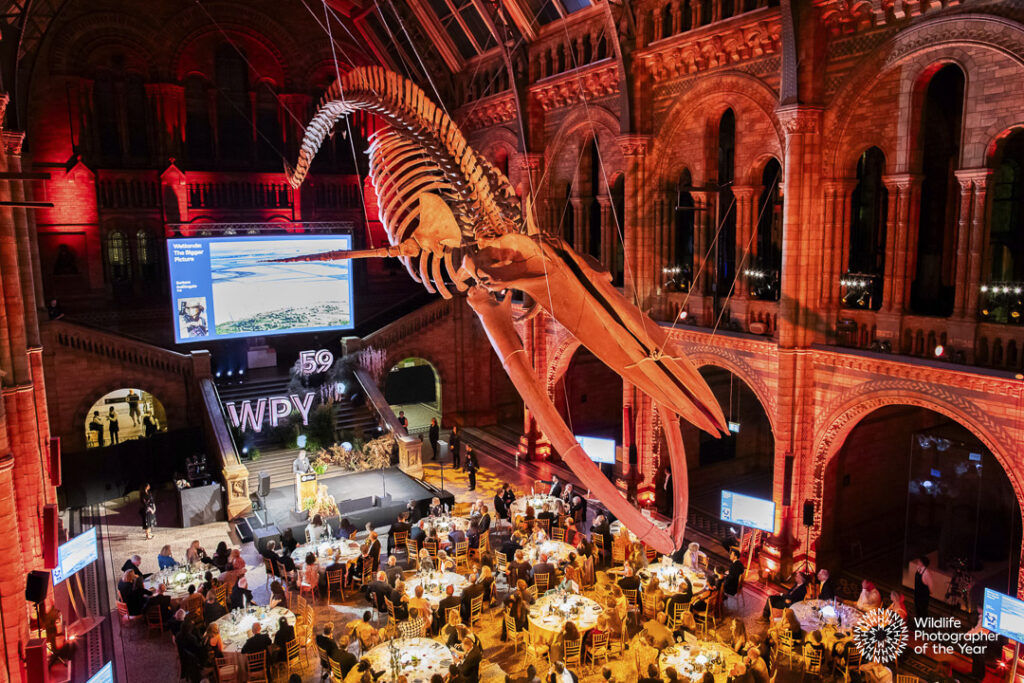
Picture credit to the Trustees of the National History Museum, London
What a special experience to be here live! We sat down at our table. During the meal, all pictures were presented and the category winners could also give a short speech. Around half past 11 in the evening it was my turn. I had quickly typed out my speech on my phone that afternoon and it went fine.
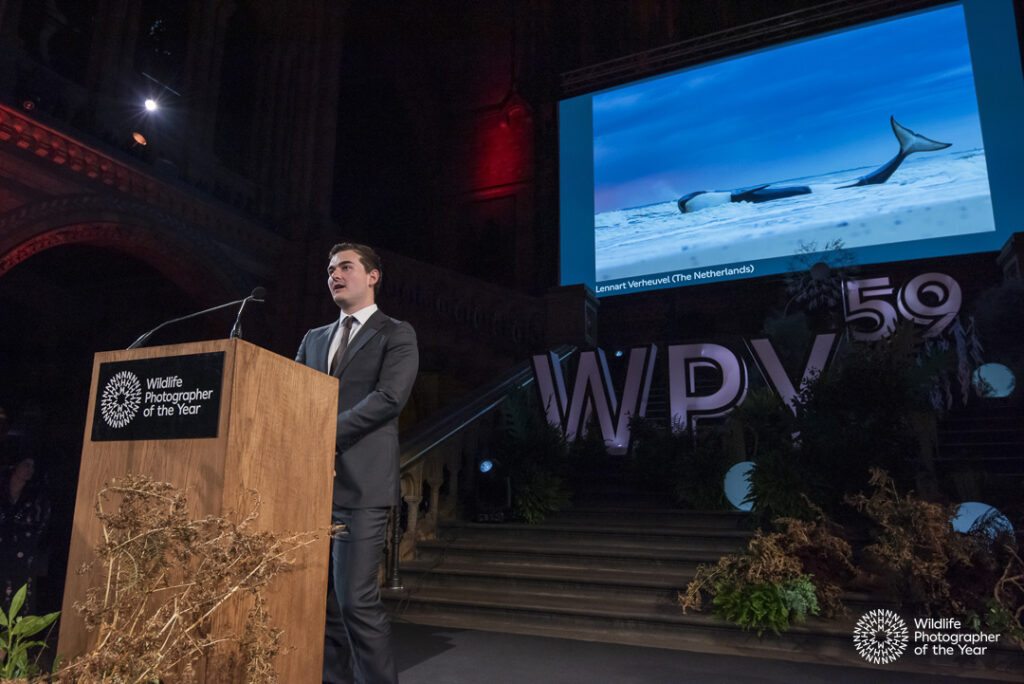
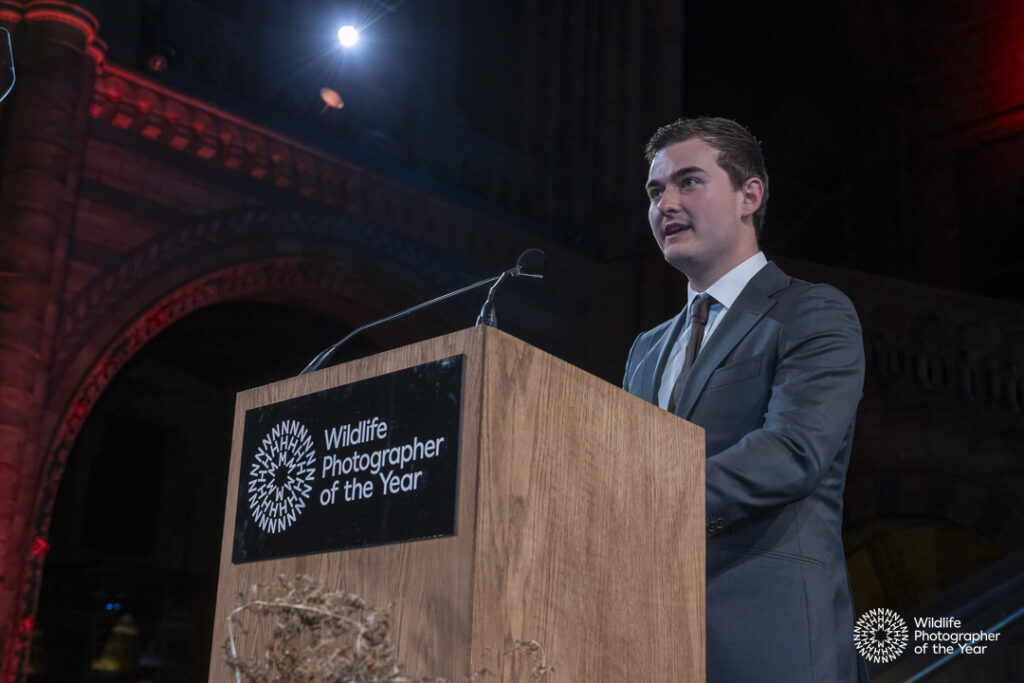
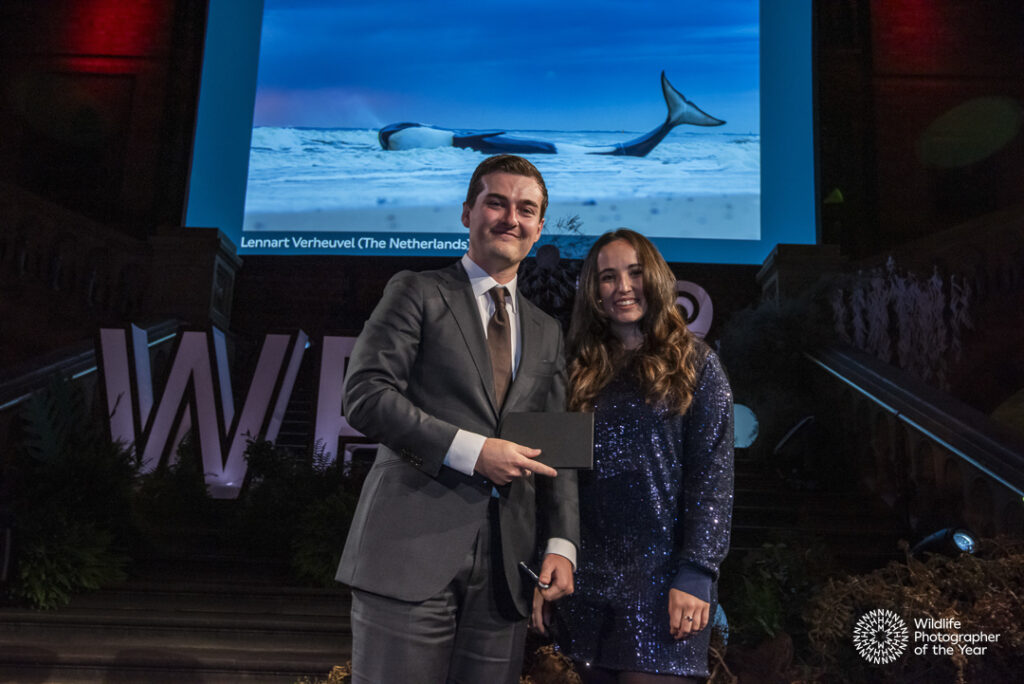
Pictures credit to the Trustees of the National History Museum, London
I sat back down with my certificate in hand. It was very cool to hear what others thought of my photo and that it had apparently stirred up some emotions.
At the end of the evening came the moment that was still a surprise for everyone: the announcement of the Young Wildlife Photographer of the Year and the Grand Title Winner. Those titles went to Carmel Bechler and Laurent Ballesta respectively. Of course, I had also secretly dreamed a little about the Grand Title, but I had not seriously considered it. Laurent Ballesta’s photo was indeed very special of an extraordinary species.
After all the prizes had been awarded, we had our picture taken with all the photographers.
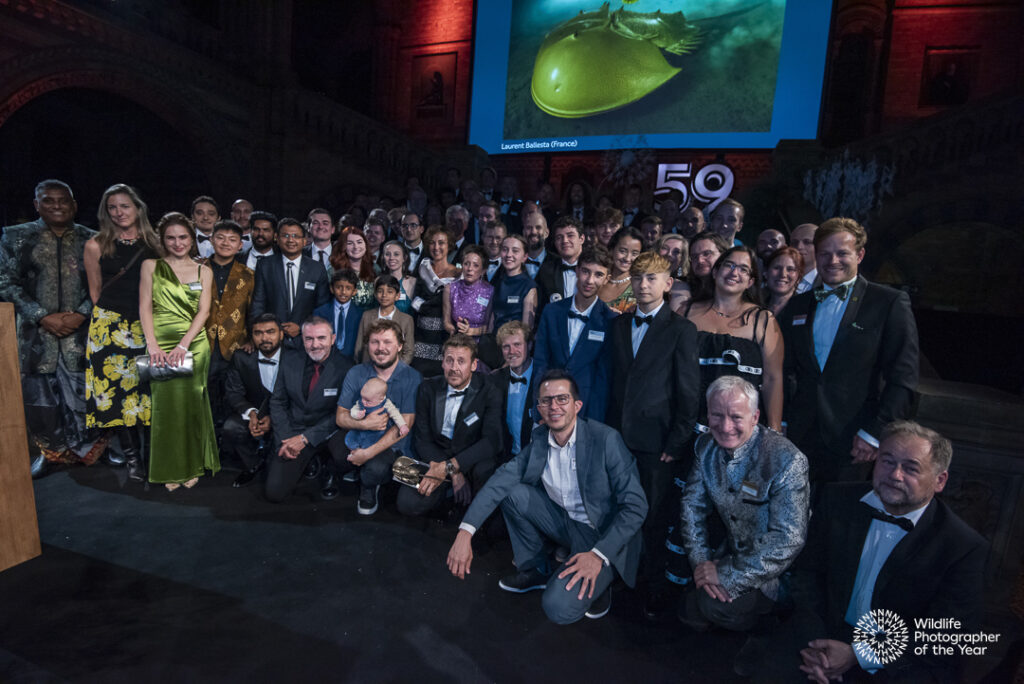
Afterwards we were also allowed to have our picture taken on stage.
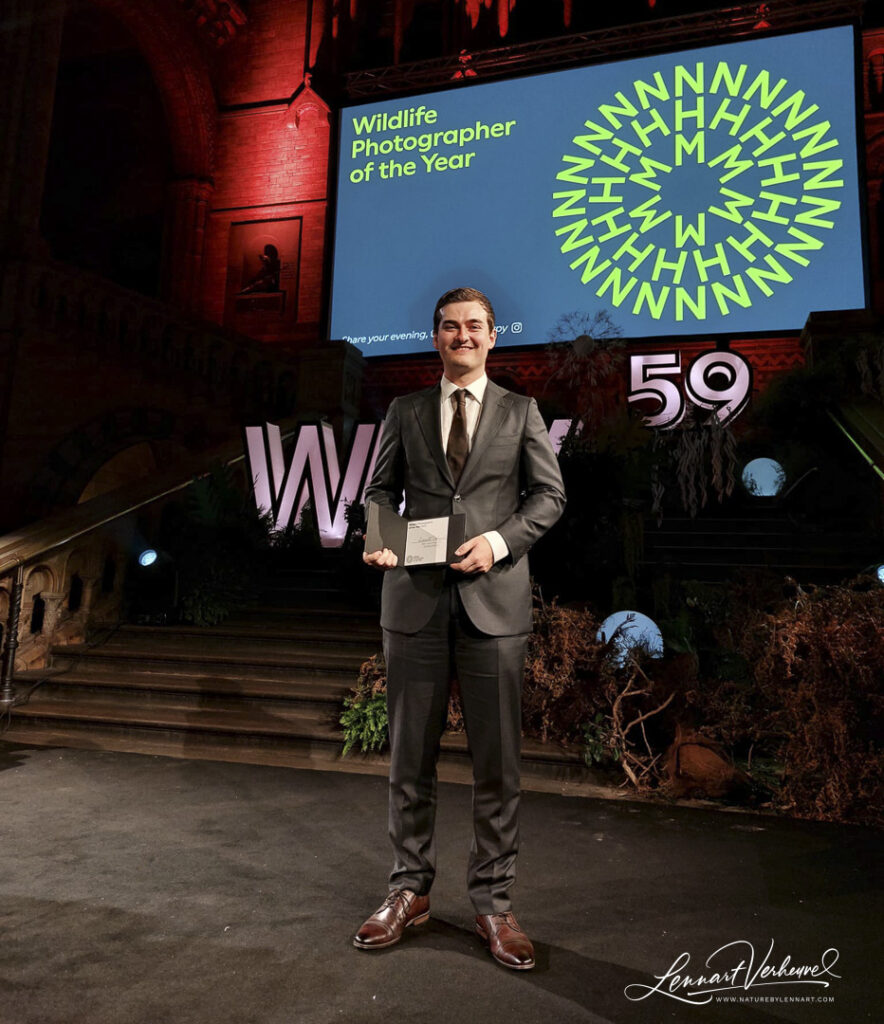
Finally, there was time for a special dessert with all kinds of garden-themed desserts. They were beautifully made and tasted great. Late in the night we were also allowed to take a first look at the exhibition where our own photos were hanging. I thought the exhibition was very nicely designed and the colors of the photos came out very well.
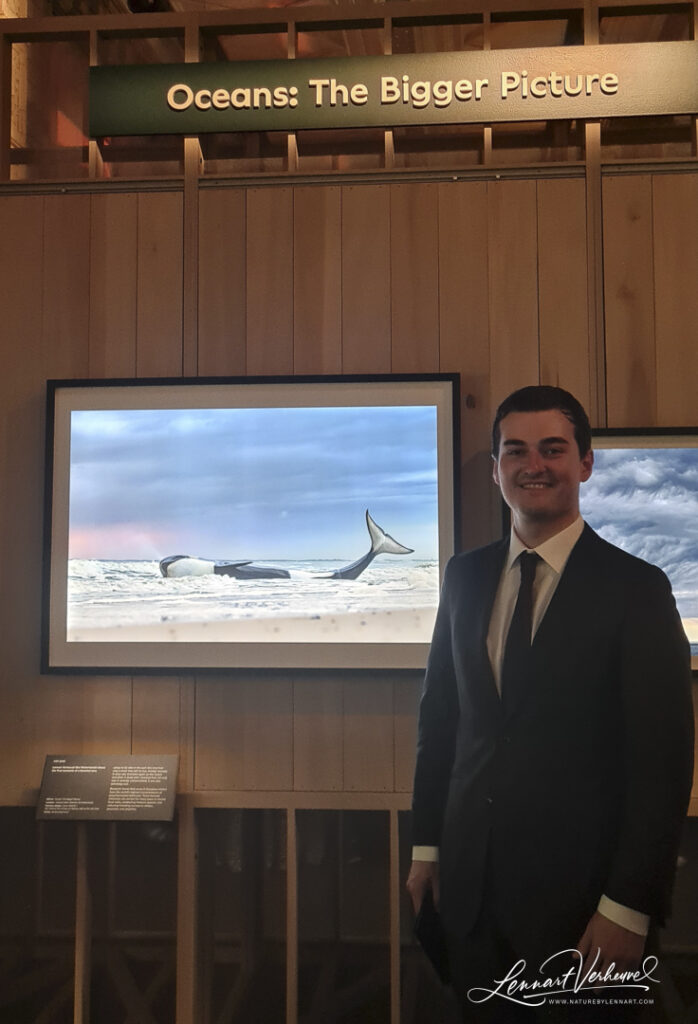
We went to bed late, but the next morning we were expected back at the museum at eight o’clock for the Press Preview. A number of journalists were given the opportunity to take a first look at the exhibition and interview photographers. For me it was mainly just chatting with some people I had met during these few days. After that morning we went back to the hotel and packed our things. At 6 o’clock in the evening we were on the train back to the Netherlands.
The next day I had to go back to work, but I was mainly busy answering questions from the Dutch press. Early in the morning I had the opportunity to talk about my picture on the radio at Omroep Zeeland. I had also already been called the previous day by people from the Humberto talkshow to ask if I was interested in being their guest that evening and that was confirmed that morning. Then the NOS Jeugdjournaal called and I also had a conversation with them via Teams. In the afternoon a camera crew from the GoedNieuws Vandaag program came by to record my work and also conducted an interview. In the evening I left for Amsterdam to participate in the talkshow Humberto and had a nice conversation with presenter Humberto Tan about my photo and also about other photos. Humberto also takes photographs in nature and that of course creates a bond! After Thursday everything calmed down again although I still received a lot of reactions to my photo. It was nice to hear how many people had seen my photo. On the Tuesday of the following week, the PZC came by and I actually ended up on the front page. That was a nice ending and I am now quietly returning to being an Unknown Dutchman again:). For those interested, excerpts and links to my media appearances can be viewed via my Instagram (click on the highlight ‘WPY 59’). Now time to get some photos together for WPY 60!